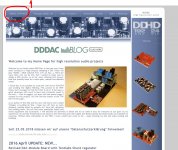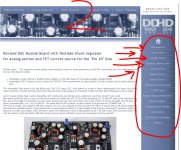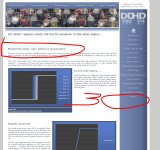Hi,
Sometimes I face designs that use 2 (or even more) DACs per channel, i.e. a stereo DAC board utilizes 2+ stereo DAC chips. What are the benefits (if any)?
Just averaging nonlinearity of multiple DACs or something else?
The theoretical limit is 6 db (for 2 DACs), correct?
What is the practical value?
Thanks,
Serge
Sometimes I face designs that use 2 (or even more) DACs per channel, i.e. a stereo DAC board utilizes 2+ stereo DAC chips. What are the benefits (if any)?
Just averaging nonlinearity of multiple DACs or something else?
The theoretical limit is 6 db (for 2 DACs), correct?
What is the practical value?
Thanks,
Serge
Most DACs are current output devices. Multiplying the number of DACs will multiply the full-scale current. It has benefit with passive I/V conversion, i. e. the output current will be converted to voltage on a resistor. By multiplying the number of DACs you will get higher audio voltage.
Thank you! It becomes clearer.
The more voltage the less noise. Especially assuming the analog part (opamp based filters) doesn’t make THD worse on higher levels.
But I saw (for instance) AK4490 x 2 (delta-sigma DAC) constructions as well. So most probably the principle works for voltage output devices as well, not for current output once only. Correct?
And so called “mono mode” typically gives additional 3db to S/N ration.
Is “3 db to S/N” really the only reason to use “double DACing” (at a double price)?
The more voltage the less noise. Especially assuming the analog part (opamp based filters) doesn’t make THD worse on higher levels.
But I saw (for instance) AK4490 x 2 (delta-sigma DAC) constructions as well. So most probably the principle works for voltage output devices as well, not for current output once only. Correct?
And so called “mono mode” typically gives additional 3db to S/N ration.
Is “3 db to S/N” really the only reason to use “double DACing” (at a double price)?
Actually I’m not using yet, just choosing.
I’d like to replace DACs in a third party DSP processor/crossover that have 6 output channels,
so I need 3 stereo DAC boards finally.
The original DSP has six channel AK4356 (on the circuit diagram), but 8 channel AK4358 is actually soldered (2 channels of 8 are just “grounded”. The practical spectra (say so) not too good,
rather practically unacceptable. I can even see non-harmonic components in the spectra, the spectra on I2S lines is pretty good though.
As the result I need to order 3 stereo I2S DACs (6 channels in total). The choice is not too wide among the ready-to-use boards. The unconditionally good variants are expensive and of significant size, I’d like to put all the boards into the same original chassis. So I’m trying to find small boards that are available as well. Some of the them have 2 DACs per channel soldered, i.e. 2 DAC chips on the board (PCM1794 and AK4490 based for instance). Their price is exactly double comparably with the single DAC chip boards. As the overall price (3 board required) makes sense but quality improvement is hardly significant (3db in S/N) I would likely choose single chip stereo DACs
>With el-cheapo recycled ones its far from the case
Hmm, I couldn’t say that, the double DAC boards I saw don’t summarize currents before the I/V converter. They strictly have 2 sets of components for each DAC chip, i.e OPAs, caps, resistors etc
I’d like to replace DACs in a third party DSP processor/crossover that have 6 output channels,
so I need 3 stereo DAC boards finally.
The original DSP has six channel AK4356 (on the circuit diagram), but 8 channel AK4358 is actually soldered (2 channels of 8 are just “grounded”. The practical spectra (say so) not too good,
rather practically unacceptable. I can even see non-harmonic components in the spectra, the spectra on I2S lines is pretty good though.
As the result I need to order 3 stereo I2S DACs (6 channels in total). The choice is not too wide among the ready-to-use boards. The unconditionally good variants are expensive and of significant size, I’d like to put all the boards into the same original chassis. So I’m trying to find small boards that are available as well. Some of the them have 2 DACs per channel soldered, i.e. 2 DAC chips on the board (PCM1794 and AK4490 based for instance). Their price is exactly double comparably with the single DAC chip boards. As the overall price (3 board required) makes sense but quality improvement is hardly significant (3db in S/N) I would likely choose single chip stereo DACs
>With el-cheapo recycled ones its far from the case
Hmm, I couldn’t say that, the double DAC boards I saw don’t summarize currents before the I/V converter. They strictly have 2 sets of components for each DAC chip, i.e OPAs, caps, resistors etc
PCM1794A
Single Nvarcher HIFI PCM1794A DAC Audio Decoder Assembled Board IIS Input 24Bit 192khz DC 5V|Digital-to-Analog Converter| - AliExpress
Double HiFi Parallel PCM1794A PCM1794 1794 DAC Audio Decoder Assembled Board 24Bit 192kHz|Digital-to-Analog Converter| - AliExpress
(ordered a single one for testing so far)
If you have an alternative for me to look at please let me know.
The only practical alternative I know at the moment is ES9038Q2M board
like ES9038Q2M ES9038 Q2M I2S DSD Optical Coaxial Input Decoder DAC Headphone Output HiFi Audio amplifier Board|board|board boardboard amplifier - AliExpress
Already tested this one and had to solder it a bit, reflash the firmware to make it decent and have THD closer to the ESS specifications. Originally the spectrum was unacceptable (H3 at -86db)
Single Nvarcher HIFI PCM1794A DAC Audio Decoder Assembled Board IIS Input 24Bit 192khz DC 5V|Digital-to-Analog Converter| - AliExpress
Double HiFi Parallel PCM1794A PCM1794 1794 DAC Audio Decoder Assembled Board 24Bit 192kHz|Digital-to-Analog Converter| - AliExpress
(ordered a single one for testing so far)
If you have an alternative for me to look at please let me know.
The only practical alternative I know at the moment is ES9038Q2M board
like ES9038Q2M ES9038 Q2M I2S DSD Optical Coaxial Input Decoder DAC Headphone Output HiFi Audio amplifier Board|board|board boardboard amplifier - AliExpress
Already tested this one and had to solder it a bit, reflash the firmware to make it decent and have THD closer to the ESS specifications. Originally the spectrum was unacceptable (H3 at -86db)
Last edited:
I fail to see any theoretically improvement for e.g. TDA1541 that has a output voltage compliance of +-25mV - except the reduction of noise due to arbitrary averaging.
You do not gain anything by paralleling them in regards of higher output due to lower passive I/V resistance. What do I miss?
You do not gain anything by paralleling them in regards of higher output due to lower passive I/V resistance. What do I miss?
Last edited:
You are generally right, for me at least. Some DACs just have special MONO mode/pin.
e.g. PCM1794 declares S/N 3 db-s lower in MONO mode.
Following the datasheet it's not a paralleling, MONO mode gives balanced output from +DACL and - DACR, the both with their own I/V. So with balanced input the voltage is doubled.
e.g. PCM1794 declares S/N 3 db-s lower in MONO mode.
Following the datasheet it's not a paralleling, MONO mode gives balanced output from +DACL and - DACR, the both with their own I/V. So with balanced input the voltage is doubled.
Most DACs are current output devices. Multiplying the number of DACs will multiply the full-scale current. It has benefit with passive I/V conversion, i. e. the output current will be converted to voltage on a resistor. By multiplying the number of DACs you will get higher audio voltage.
No you will not as there are limits to the max voltage across the I/V load.
read my website on the DDDAC1794 and you will have all background on mono mode, and what parallel DACs really bring. The S/N ration is of no importance by the way...
www.dddac.com
The link is in my post below 
For me it works
DDDAC 1794 NOS DAC - Non Oversampling DAC with PCM1794 - no digital filter - modular design DIY DAC for high resolution audio 192/24 192kHz 24bit
For me it works
DDDAC 1794 NOS DAC - Non Oversampling DAC with PCM1794 - no digital filter - modular design DIY DAC for high resolution audio 192/24 192kHz 24bit
are you kidding me Serge? The site is full with detailed technical information and I explain all design steps in detail. Also my idea of why paralleling dac chips is beneficial... You must follow the links and there is also a site map
ok I made a step 1 to 3 help screenshots below.... hope it will work for you now?
Doede
ok I made a step 1 to 3 help screenshots below.... hope it will work for you now?
Doede
Attachments
- Home
- Source & Line
- Digital Line Level
- 2 DACs per channel benefits


